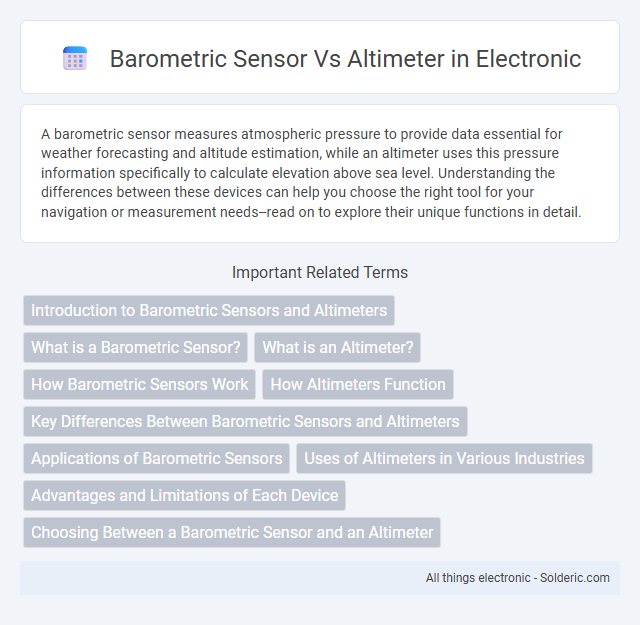A barometric sensor measures atmospheric pressure to provide data essential for weather forecasting and altitude estimation, while an altimeter uses this pressure information specifically to calculate elevation above sea level. Understanding the differences between these devices can help you choose the right tool for your navigation or measurement needs--read on to explore their unique functions in detail.
Comparison Table
| Feature | Barometric Sensor | Altimeter |
|---|---|---|
| Function | Measures atmospheric pressure | Measures altitude based on atmospheric pressure |
| Primary Use | Weather monitoring, pressure tracking | Altitude detection in aviation, hiking, climbing |
| Output | Pressure in hPa or mmHg | Altitude in meters or feet |
| Dependency | Direct atmospheric pressure | Calculated from barometric pressure & reference sea level pressure |
| Accuracy Factors | Temperature, sensor calibration | Pressure changes, weather conditions |
| Common Sensors | MEMS barometers (e.g., BMP280, BME280) | Integrated barometric altimeters (e.g., in Garmin watches, smartphones) |
Introduction to Barometric Sensors and Altimeters
Barometric sensors measure atmospheric pressure to determine changes in elevation or weather conditions by detecting air pressure variations. Altimeters use these pressure readings from barometric sensors to estimate altitude, providing critical data for aviation, hiking, and outdoor navigation. You can rely on barometric altimeters to deliver precise altitude measurements by interpreting the sensor's atmospheric pressure data accurately.
What is a Barometric Sensor?
A barometric sensor measures atmospheric pressure to determine changes in altitude and weather conditions. Unlike a traditional altimeter, which directly displays altitude, a barometric sensor provides precise pressure readings that can be converted into altitude data using algorithms. Your devices rely on barometric sensors to enhance accuracy in navigation, weather forecasting, and altitude tracking.
What is an Altimeter?
An altimeter is a precision instrument that measures altitude by detecting atmospheric pressure variations using a barometric sensor. It converts air pressure readings into height above a fixed reference point, commonly sea level, providing critical data for aviation, hiking, and weather monitoring. Unlike standard barometric sensors that only track pressure changes, altimeters specifically translate these changes into altitude measurements.
How Barometric Sensors Work
Barometric sensors measure atmospheric pressure using a sensitive pressure transducer that detects air pressure changes and converts them into electrical signals. These sensors are commonly used in altimeters to determine altitude by comparing the measured air pressure to a reference pressure at sea level. The decrease in atmospheric pressure with increasing altitude allows barometric sensors to estimate elevation accurately for aviation, weather monitoring, and outdoor navigation applications.
How Altimeters Function
Altimeters function by measuring air pressure changes using a barometric sensor, which detects the decrease in atmospheric pressure as altitude increases. This sensor translates pressure variations into altitude readings by comparing current air pressure with a known reference pressure at sea level. The accuracy of altimeters depends heavily on the precision of the barometric sensor and calibration against standard atmospheric models.
Key Differences Between Barometric Sensors and Altimeters
Barometric sensors measure atmospheric pressure to provide precise data used in various applications, while altimeters specifically convert this pressure data into altitude information for navigation and aviation. The main difference lies in their purpose: barometric sensors serve as raw pressure detectors, whereas altimeters interpret this pressure to determine height above sea level. Understanding how your device uses these components can enhance accuracy in elevation tracking and weather prediction.
Applications of Barometric Sensors
Barometric sensors are widely used in weather forecasting, aviation, and portable electronic devices to measure atmospheric pressure accurately. These sensors enable precise altitude determination in altimeters by detecting pressure changes, crucial for aircraft navigation and outdoor sports like hiking and skydiving. Their integration into smartphones and smartwatches enhances location-based services and fitness tracking by providing reliable elevation data.
Uses of Altimeters in Various Industries
Altimeters, integral to aerospace, aviation, and outdoor sports industries, provide precise altitude measurements critical for flight navigation, parachuting, and mountaineering safety. In weather forecasting and environmental monitoring, barometric altimeters contribute to accurate atmospheric pressure data crucial for predicting weather changes. The automotive and drone industries also leverage altimeters to enhance vehicle performance and ensure stable flight operations.
Advantages and Limitations of Each Device
Barometric sensors offer precise atmospheric pressure measurements crucial for weather monitoring but can be affected by local pressure changes and require calibration for altitude estimation. Altimeters, particularly barometric altimeters, provide reliable altitude readings by interpreting pressure data but may suffer inaccuracies due to temperature fluctuations and weather conditions. While barometric sensors excel in environmental data collection, altimeters are more specialized for navigation and elevation tracking, each with specific strengths and limitations based on application context.
Choosing Between a Barometric Sensor and an Altimeter
Choosing between a barometric sensor and an altimeter depends on accuracy and application needs. A barometric sensor measures atmospheric pressure for general altitude trends, ideal for fitness tracking and weather monitoring, while an altimeter provides precise altitude data critical for aviation and hiking. Your decision should consider whether you require detailed elevation measurements or broader environmental insights.
barometric sensor vs altimeter Infographic

 solderic.com
solderic.com